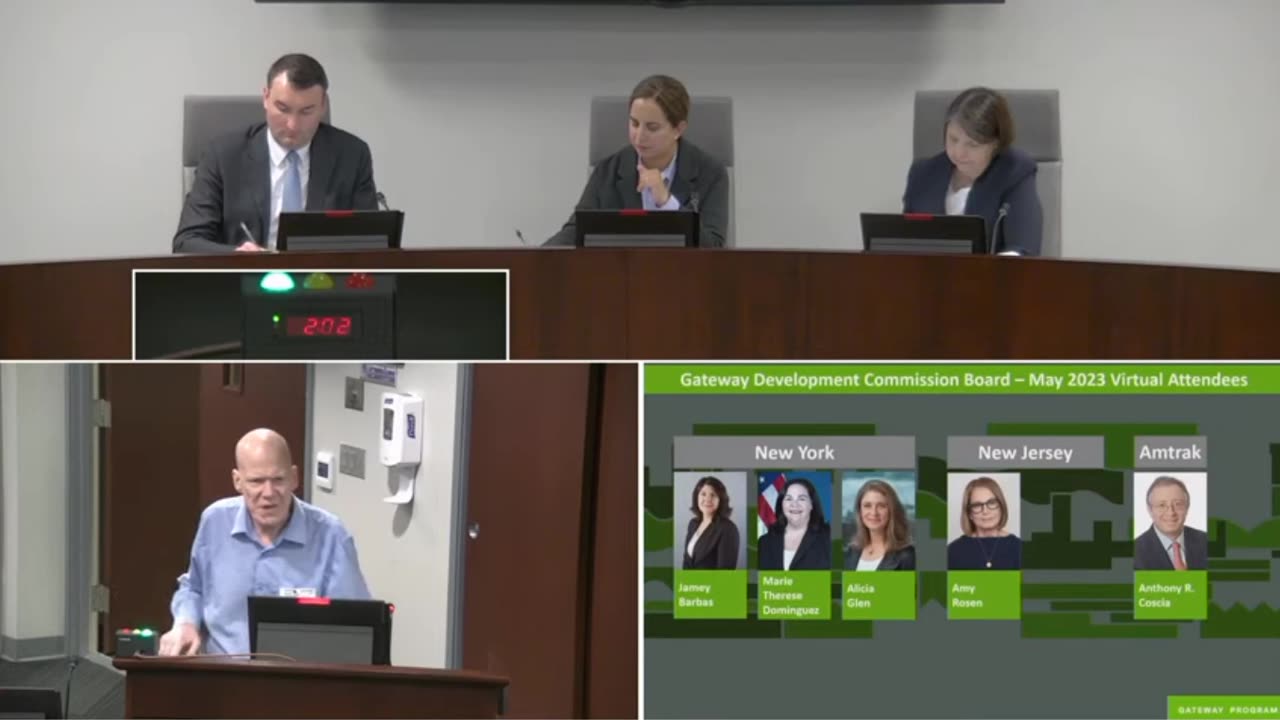Premium Only Content

"Tunnel must be Demolished" - Gateway Tunnel Commission, 5/2/23 (see the description for details))
I MUST RECANT! The old description of the ground stabilization project was so precise and carefully presented that I never stopped to think they might revise it. Apparently this new version - with a 550-foot-long cofferdam and hardening of the river bottom that extends into the navigation channel - includes a revised alignment of the as yet only partially built "box" in Manhattan: to make the west end higher, thus reducing the former three-or-so-percent grade to 2.1%. (It appears this will involves introducing a reverse curve in the vertical alignment of "the box".) The tunnel will now enter the river bottom at one side and run along a uniform 'inclined plane' to the other. It is a novel solution - and I would say ill-advised - to build a rail tunnel through a tidal estuary so close to the bottom of a big navigable channel. And the general standard for low cover in NORMAL conditions is one tunnel breadth, not one half, as the new documentation asserts.The ruling grade in the old tunnel is something like 1.97% - and it runs considerably deeper under the river bottom than the new one.
I still say the old tunnel needs to be demo'd and rebuilt, because the south tube flexes quite a bit on the Jersey side where locomotives pass from bedrock into the wet, silty river bottom at 60 mph - every three minutes for the past 114 years. By far the most severe leaking and water damage in all the six underwater Penn Station tunnels occurs at this location. To some degree it's probably due to the old method of construction, with a continuous row of cast iron "key segments" running the length of the bored section at the top, which are stiffer than the normal segments comprising the remainder each ring. Most of the severe leaking occurs on either side of these stiffer key segments. (my theory, I have no bona fides)
The whole tunnel moves up and down with the tide measured in inches, but that's normal. Damage to reinforced concrete left unattended still twelve years after the fact cannot be repaired, and the deterioration "progresses exponentially" - to quote an oft' repeated-by-engineers description of the process. (like the Surfside condominium tower) The one English bidder with an astronomical price did not contemplate anything like replacing the 40 special 1-inch-thick lengthwise re-bars (which were sort of an afterthought) spliced together at intervals and running the length of the bored segment, i.e. 1.25mi. - times two. Without, the old re-bars will just start to rust again, and any new concrete will pop right off in a matter of a few years, leaving the re-bars exposed to continue rusting. Nor did they contemplate taking the concrete lining down to bare metal (necessary for visual inspection, making repairs, plugging leaks, and arresting the rust) which would probably be dangerous, and require working under pressure - THUS COSTING MORE THAN IT WOULD TO DEMOLISH AND REBUILD THE TUNNEL.
The bored segments (two) are each about 1.25 miles long. The still-longer underground approaches - mined through bedrock at cost of life and limb - are already in place. See: Hudson Tunnel Project vs. the Correct Alternative, at https://www.rail-nyc-access.com - for more on the exponentially complicating factors involved in getting this project wrong - results of which will be permanent.
-
 2:14:09
2:14:09
LFA TV
23 hours agoRUMBLE RUNDOWN WEEK 6 with JEREMY HERRELL AND SHAWN FARASH 11.15.25 9AM
170K8 -
 1:44:16
1:44:16
HotZone
7 hours ago $5.80 earnedLive: The Hidden Crisis in US Special Ops: What They’re Not Telling You About Women in Combat
19.6K18 -
 53:25
53:25
Athlete & Artist Show
21 hours ago $2.73 earnedBombastic Bets & Games w/ Team Canada Veteran!
19.4K1 -
 53:13
53:13
X22 Report
6 hours agoMr & Mrs X - It All Revolves Around Marxism, Think Political Correctness, Midterms Are Safe - EP 16
81.2K23 -
 44:27
44:27
I_Came_With_Fire_Podcast
12 hours agoThe Right's Drift into Neo-Marxism & America's Populist Crossroads
17.2K11 -
 LIVE
LIVE
Amarok_X
5 hours ago🟢LIVE 24 HR STREAM? | ARC RAIDERS TO START | OPERATION 100 FOLLOWERS | USAF VET
48 watching -
 3:53:58
3:53:58
Pepkilla
5 hours agoDay 2 of Camo Grinding Black Ops 7 ~ Until My Brain Rots
8.11K2 -
 27:34
27:34
marcushouse
7 hours ago $1.76 earnedWOW! I Was NOT Ready For This One… 🤯 | Starship & New Glenn Lead The Race!
6.1K2 -
 LIVE
LIVE
MrR4ger
7 hours agoD4RK and D4RKER TO START THEN ARC R4IDERS W/ TONYGAMING AND AKAGUMO
37 watching -
 4:21:39
4:21:39
Shield_PR_Gaming
5 hours ago11/15/25 Hittin some Bodycam a bit as well as other games!
2.44K1